The Christmas Eve fire that burned downtown Richmond
By Gregory Harutunian For Chronicle Media — December 24, 2018
The concrete facade for the State Bank of Richmond, built in 1890, marks the point where the fire stopped and changed direction to the east. (Photo by Gregory Harutunian/for Chronicle Media)
The Village of Richmond is also known as The Village of Yesteryear, for the quaint appearance of its historic downtown business district, bordered roughly by Main, Mill, and Broadway streets. Walking the area brings back the sense of a bygone era with mantle plaques on the commercial buildings displaying dates from 1903-14. Outlying residential homes reflect architecture “cast in the Italianate or Second Empire styles.”
Observations of the town’s early existence, according to Gail Drabant’s “History of the Covell House,” noted that William A. McConnell had erected a log cabin in 1837, becoming the region’s initial settler. From 1840-60, most of the original town resembled a patchwork quilt consisting of farmhouses, a school on the McConnell property, several businesses, and the main commercial district.
That commercial district, the historic downtown area, is the subject of a tale that resurfaces annually at Christmastime, although not as a conventional story in keeping with the season. The story is recorded in old journals, a Jan. 1, 1903 article from the now-defunct Richmond Gazette, and other antiquated publications.
A cryptic paragraph from Drabant’s narrative, states, “On Christmas Eve 1902, a devastating fire swept through most of Richmond’s commercial district, destroying twenty buildings. The fire was a setback for Richmond’s economic growth as most of the buildings were either uninsured or underinsured. Many business owners did not bother to rebuild at all, following the fire.”
Kurt Begalka, administrator for the McHenry County Historical Society, located the 1832-1898 McHenry County history book which describes the Christmas fire as “Richmond’s worst. At 1 a.m., those living in the ‘flats’ near Main and Broadway streets smelled burning wood … apparently from the rear of the bakery. The fire raged through the Richmond Gazette’s printing plant, and another 20 downtown buildings.
In his own assessment, Begalka added, “Back then, fire was a constant threat. The combination of old wood and open flames frequently proved disastrous. Couple that with cold temperatures, strong winds and the inaccessibility of water, think bucket brigade here, and it is really quite amazing that the outcome was not worse. I just wondered how they were able to rebuild so quickly.”
The Richmond Gazette’s article concurred the flat-dwellers were “aroused by the smell of burning wood. Upon investigation, fire was found to be raging in the rear of the building, occupied by A. Fisher, in a bakery-restaurant, and the partition between the kitchen and William Nyquist’s drug store.”

The Schroeder house was the scene of Ralph “Darb” Kilburn’s efforts to save the structure, by standing on the roof’s pinnacle and throwing water onto horse blankets. (Photo by Gregory Harutunian/for Chronicle Media)
Considered too far gone to save, the city marshal was notified and the lone fire engine was brought into action. Fire consumed the jewelry store and meat market on either side of the structure, working its way to the Rice Bakery and Restaurant heading south.
The adjoining Velsey Tailor Shop, soon engulfed with flames, helped the blaze wind around the corner to a millinery shop. A bucket brigade was formed, chain-carrying containers of water and hand-thrown onto the fire. The conflagration halted at the walls of the old bank building on Broadway Street.
Unfortunately, the heat set other buildings into flame on the east side of the street consuming the Nash Grocery Store, Wray’s Undertaking and Furniture Establishment, along with the Gazette’s own printing and news offices. Johnott’s Grocery in the former 1905 Emporium building, and the city jail also burned to the ground.
Saving the nearby Schroeder house was a “scene of a valiant and successful attempt by Ralph ‘Darb’ Kilburn to arrest a raging fire … Kilburn sat on the topmost pinnacle throwing buckets of water on horse blankets covering the roof until the blaze subsided.” The gazette article also said Kilburn’s clothing would ignite from the heat, and were “summarily extinguished by dashes of icy water.”
Kris Anderson, who works at the Richmond Post Office, said, “I lived in the T.C. Schroeder house, the home on the south side of the Richmond Memorial Hall, as a little girl. My mother told me the story of the fire. She said there was a horse and tack shed in the back.”
The paper’s account continued, “Kilburn’s efforts to save the Schroeder house became a focal point since it was presumed that had the walls started to burn, it could have taken the entire southeast portion of the town with it.” Kilburn was a “center of attraction,” standing on the roof’s pinnacle, and before long, many others joined to protect the house and quash the flames.
Estimates later placed damages at approximately $40,000. Although the ruined structures were uninsured, leaving no funds for rebuilding, no one was seriously hurt during the incident. Determinations “considered that a defective flue in the restaurant” was the cause of the fire.
The historic downtown business district, as it appears today, is shaped by the adversity that place on Christmas Eve 1902, and speaks to resiliency. One interesting footnote: the original city fire engine deployed that evening surfaced, decades later. The Richmond Township Fire Protection District purchased and restored the apparatus. It is now on display at their stationhouse, located at Route 12 and Hunter Drive.



